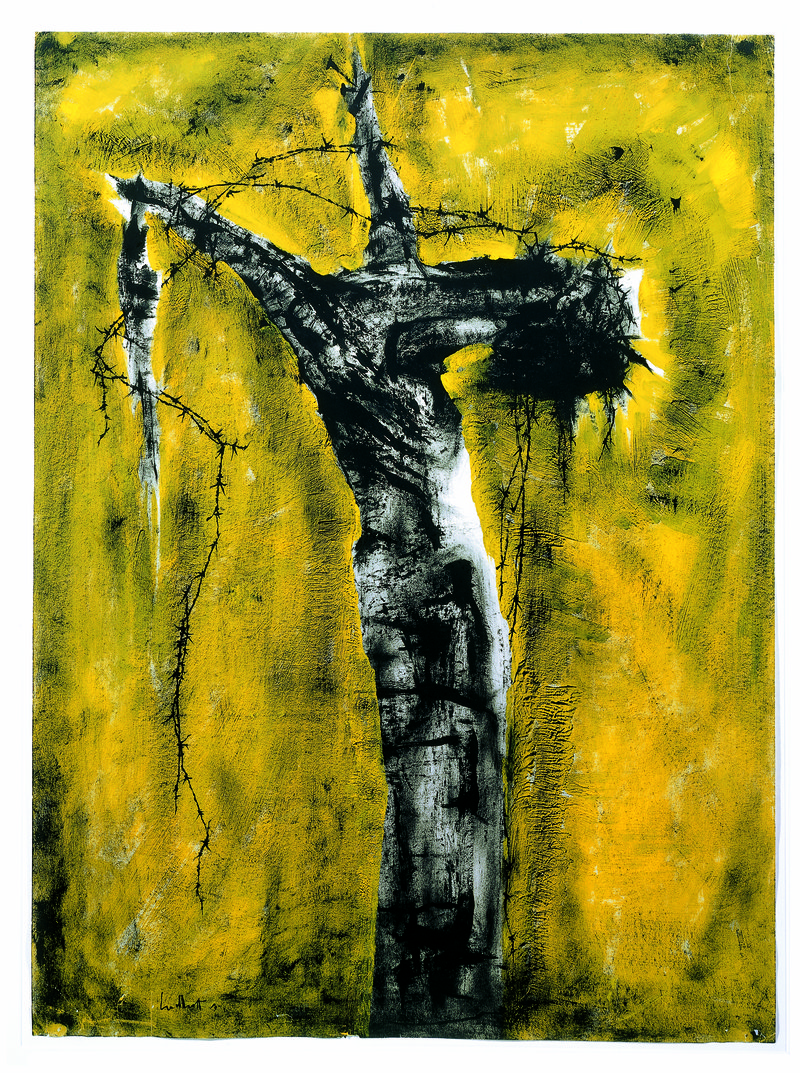
Theyre Lee-Elliott (1903-1988)
Tempera and gouache on paper
85 x 65 cm
1959
Methodist Modern Art Collection
LEE/1963
Image Copyright © Trustees for Methodist Church Purposes. The Methodist Church Registered Charity no. 1132208
Biblical commentary
Matthew 27: 35–36, 38–39
Lee-Elliott’s Crucified tree form draws on a tradition dating from the thirteenth century in which the cross on which Jesus is crucified is a living tree. In this painting, he has developed the ‘living tree’ one stage further and created a crucifixion which conveys ‘the agony’ with the head and shoulders falling forward and the arms stretched up backwards, in a V. The cross, tree and body are fused into a single suffering whole. A modern touch is added with the strands of barbed wire. In fact, there is something of the First World War battlefield about the painting; the dead trees, now a familiar icon of the twentieth century, add an additional resonance to the work.
Commentary based on A Guide to the Methodist Art Collection.
Artist biography
Born: Lewes, Sussex, 1903
Died: Chelsea, London, 1988
Early life and education
Theyre Lee-Elliott attended school at Winchester College and then studied theology at Magdalene College Cambridge (1922–24). While at Cambridge he was high jump champion, played lawn tennis for the University, and table tennis for England. These sporting achievements are considered relevant to his art because of his interest in depicting speed and movement. He went on to study at the Central School of Art and Design (1925–27), followed by the Slade School of Fine Art.
Life and career
Lee-Elliott began work teaching in a London school from 1928 to 1929, then took up a successful career as a graphic designer and commercial artist. He gained an international reputation and regularly exhibited abroad. He is best known for his book jackets, posters and logos. His celebrated design commissions include the ‘Speedbird’ symbol for Imperial Airways in 1933, the Punch stand for the Ideal Home Exhibition in 1933, and posters for Austin Reed, Shell, GPO, Southern Railway and London Transport. He also designed first edition book jackets for (among others) Hemingway’s A Farewell to Arms and Sinclair Lewis’s The Man who knew Coolidge.
Lee-Elliott is also renowned for his early paintings (from the 1930s to the 1950s) of animals, ballet and ballet dancers, and for the water colours he produced from the 1960s to the 1980s. His ballet paintings have been compared with those of Degas. When working on scenery for Sadler’s Wells Theatre and painting the ballet dancers, he made friends with many in the ballet and musical world, including the composer Constance Lambert.
Lee-Elliott was the son of an Anglican clergyman but was an agnostic, if not an atheist, throughout his life. He turned to religious painting, producing a series about the Cross and Jesus’s crucified body after being close to death in 1959. He fell ill with food poisoning and was hospitalised in Leyden, Holland. When he came to, he had an insatiable desire to paint a picture in which the wood of the Cross met the same point as the crucified body itself. Crucified Tree Form – the Agony (1959) from the Methodist Modern Art Collection is one of this series. Despite Lee-Elliott’s agnosticism, the critic Ray Watkinson said in an unattributed newspaper review of Lee-Elliott’s 1960 exhibition in the Redfern Gallery that the crucified tree-form pictures “seem a more valid religious art than most we have recently seen.”
These tree-form pictures were not his only religious works, and others are in the possession of his family. He was also one of the painters invited by St Edmund Hall, Oxford, to submit a proposal for The Supper at Emmaus for their chapel. Ceri Richards received the commission, and a version of this work is in the Methodist Modern Art Collection.
Exhibitions and collections
Lee-Elliott’s solo exhibitions include one of his posters in New York (1932), an exhibition of his ballet paintings in Hollywood (1937–1938) and a touring exhibition organised by the British Council in Australia (1939). Exhibitions of his watercolours were held in Tokyo in the 1950s, ’60s and ’70s, and two retrospective commemorative exhibitions in Sadler’s Wells Theatre, London – one of his paintings of ballet, and one of his design work.
His work is held in St Edmund Hall, Oxford, Sadler’s Wells Theatre, London, the Japanese Royal Collection, the Spanish Royal Collection, San Francisco Museum of Fine Art, USA, and (to Lee-Elliott’s delight) the Victoria and Albert Museum, London.
Sources and further reading
David Buckman, David. Artists in Britain Since 1945: Volume 1 A to L. 2 vols, (Bristol: Art Dictionaries Ltd, 2006), p. 943. The text is also available on the Art UK website: https://artuk.org/discover/artists/lee-elliott-theyre-19031988 (accessed 30 April 2025)
Theyre Lee-Elliott, Paintings of the Ballet with introduction by Arthur L Haskell (London: Collins, 1947). Available here: archive.org/details/paintingsofballe0000they/mode/2up?view=theater
Seeing the Spiritual: A Guide to the Methodist Modern Art Collection. (Oxford, 2018), pp. 74–75.
Roger Wollen, Catalogue of the Methodist Church Collection of Modern Christian Art with an Account of the Collection’s History, (Oxford: The Trustees of the Methodist Collection of Modern Christian Art, 2003), pp. 96–99.